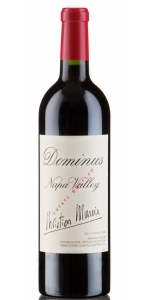Wine from Dominus
IN THE LATE 1960S, WHILE ATTENDING THE UNIVERSITY OF CALIFORNIA AT DAVIS, CHRISTIAN MOUEIX FELL IN LOVE WITH THE NAPA VALLEY AND ITS WINES. SON OF JEAN-PIERRE MOUEIX, THE FAMED WINE MERCHANT AND PRODUCER FROM LIBOURNE, FRANCE, MOUEIX RETURNED HOME IN 1970 TO MANAGE THE FAMILY VINEYARDS, INCLUDING CHATEAUX PETRUS, LA FLEUR-PETRUS, TROTANOY IN POMEROL AND MAGDELAINE IN SAINT EMILION.
HIS LOVE OF NAPA VALLEY LINGERED AND, IN 1981, HE DISCOVERED THE HISTORIC NAPANOOK VINEYARD, A 124-ACRE SITE WEST OF YOUNTVILLE THAT HAD BEEN THE SOURCE OF FRUIT FOR SOME OF THE FINEST NAPA VALLEY WINES OF THE 1940S AND 1950S. IN 1982, MOUEIX ENTERED INTO A PARTNERSHIP TO DEVELOP THE VINEYARD AND, IN 1995, BECAME ITS SOLE OWNER. HE CHOSE THE NAME ‘DOMINUS’ OR’ LORD OF THE ESTATE’ IN LATIN TO UNDERSCORE HIS LONGSTANDING COMMITMENT TO STEWARDSHIP OF THE LAND.
ONE OF THE MOST RESPECTED WINE PRODUCERS IN THE WORLD, CHRISTIAN MOUEIX IS ON A PERSONAL QUEST FOR PERFECTION IN GRAPEGROWING AND WINEMAKING. IT IS A JOURNEY THAT BEGAN IN BORDEAUX AND CONTINUES TODAY AT DOMINUS ESTATE, WHERE HE HAS INSTILLED HIS PHILOSOPHY AND INSPIRED HIS TEAM TO SHARE HIS VALUES. TO WALK THE VINEYARD WITH CHRISTIAN IS TO WITNESS A COMMITMENT TO THE LAND, A STRONG SENSE OF PURPOSE AND THE MODEST SOUL OF A MAN OF THE VINES.
Dominus Napa Valley Red Blend is made from 88% Cabernet Sauvignon, 7% Cabernet Franc, 5% Petit Verdot.
The historic Napanook Vineyard, a 124-acre site west of Yountville, was planted in 1838. This vineyard was the source of fruit for some of the finest Napa Valley wines. Estate-bottled in the spirit of the Bordeaux châteaux, Dominus Estate is dry-farmed to allow natural stress and good concentration of fruit. Grape clusters are crop-thinned to allow sun and air to pass in between, helping to achieve full maturation and soften the tannins. Only 20% to 40% new French oak barrels are used in order to limit the extraction of oak notes. To express the unique terroir, the classic Bordeaux grape varietals of Cabernet Sauvignon, Merlot, Cabernet Franc and Petit Verdot are planted with different root stocks best suited for the varying soil composition of gravel, heavy clay and loam.
Reviews:
One of the legendary Dominus, the 2021 Cabernet Sauvignon is unquestionably in the same league as the 2018, 2016, 2015, 2013, 2010, and 1991, and to my mind, wine simply doesn't get any better. Sporting a dense purple hue as well as an incredible perfume of blackcurrants, crushed stone, cedar pencil, smoke tobacco, and baking spices, it s rich, full-bodied, and voluptuously textured, with ripe yet building tannins. It reminds me slightly of the 2010 (maybe the 2013), and I suspect it will have a similar evolution. Hide bottles for 7-8 years, and it will evolve gracefully for 30+ years. Hats off to the team of Christian Moueix and director Tod Mostero.
Jeb Dunnuck 100 Points
- back
Selected Options
Wineries
Categories
Pricing
Countries
Regions
Grape Types
Wineries
Organic/Free Shipping
Evening Land Seven Springs Vineyard Summum Chardonnay is made from 100 percent Chardonnay.
Summum Chardonnay is the unofficial tête de cuvée of our lineup at Evening Land Vineyards. Fruit for Summum comes from just 14 vine rows that form the backbone of the Seven Springs Estate. Here, soils were formed by ancient volcanic eruptions that sent blazing lava down the current vineyard’s slopes – and today, we’re lucky enough to farm our vines in these mineral-laden soils. The 2019 Summum Chardonnay is medium-bodied and bright, marked by flavors of lemon skin, baked apple, and a touch of sweet spice that leads to a satiny, harmonious finish. For a unique taste of Oregon’s rather untapped potential for high-end Chardonnay, this bottle is it.
Review:
Shows dimension and presence, with elegantly multilayered flavors of Meyer lemon, apple skin, yeasty lees and crushed stone that gather richness and steely opulence on the lingering finish. Drink now
-Wine Spectator 95 Points
La Crema Fog Veil Pinot Noir is made from 100 percent Pinot Noir.
A lush, earthy, and balanced Pinot Noir from select estate vineyards in California's famous Russian River Valley. This red wine opens with aromas of wild strawberry, blackberry, and cardamom. Flavors of boysenberry, raspberry, and sassafras with hints of baking spice. Soft tannins are balanced by vibrant acidity. This Red Wine has a Cork closure. Alcohol Content: 14.8% Pair with grilled filet mignon, bacon wrapped pork tenderloin and camembert. Aromas of wild strawberry, blackberry, and cardamom. Flavors of boysenberry, raspberry, and sassafras with hints of baking spice. Soft tannins are balanced by vibrant acidity.
Review:
Tremendous energy is conveyed through a guiding light of spiced cher- rywood and notes of tea leaves and flint. Rich and concentrated, with a hint of smoked cedar on the finish. The grapes come from neighboring estate vineyards in the Santa Rosa Plains region of the Russian River Valley.
-Tasting Panel 94 Points





